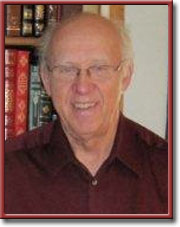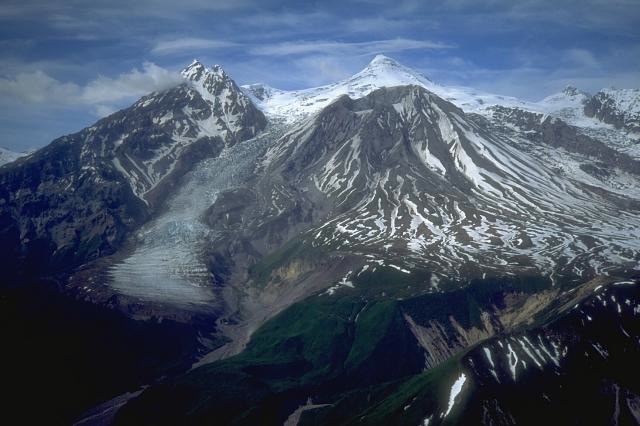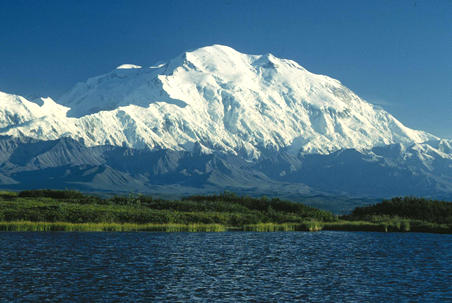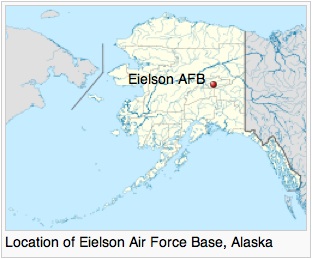North to Alaska
Out to Pastoral
by John Idol
 HILLSBOROUGH, NC—(Weekly Hubris)—2/14/11—When in early May, 1953, a Military Air Transport [MAT] plane taxied to a hangar at Eielson Air Force Base in Alaska, I joined other airmen in a photomapping crew for four months of temporary duty. Our assignment: help complete a more precise map of the territory, for Alaska was not yet a state. We were to do it by radar (Shoran—short range aerial navigation) and the cameras to which they were linked.
HILLSBOROUGH, NC—(Weekly Hubris)—2/14/11—When in early May, 1953, a Military Air Transport [MAT] plane taxied to a hangar at Eielson Air Force Base in Alaska, I joined other airmen in a photomapping crew for four months of temporary duty. Our assignment: help complete a more precise map of the territory, for Alaska was not yet a state. We were to do it by radar (Shoran—short range aerial navigation) and the cameras to which they were linked.
Getting there on a MAT cargo plane was not how I’d envisioned arriving. Since high school days, I’d dreamt of buying a Piper Cub and flying it there solo.
I’d collected photos of Alaska and sent away for information on Piper Cubs.
Someday, somehow, I’d explore, pan for gold, land a prize salmon, outrun a grizzly, and rub noses with an Eskimo. In short, I’d be an adventurer, footloose, fancy-free, maybe even heroic. I’d shoulder aside Robert Service and Jack London as a teller of north country tales.
So much for the dream: now for the reality. Located 26 miles from Fairbanks, Eielson was not America the beautiful—no fruited plain, no purple mountain majesty, no fields of waving grain, nothing like that batch of photos I’d pored over, except for the spacious sky. But it was a place for launching trips and refueling the mind.
Our mission involved a close relationship among a crew flying a converted B-50 bomber equipped with airborne radar equipment and other men supporting them on the ground, some as airplane mechanics, others as operators and repairmen of ground radar stations, still others as mapmakers.
Because electronic photomapping depends on measurement accomplished through a triangulation of signals from ground-based radar sets and an airborne set, ground units were set up in several locations. These units were situated from the Alaskan coast to a point above the Arctic Circle. They had to be maintained or repaired.
And that’s where Jim Gray and I came in, for our assignment was to keep the ground units humming. Getting to a ground unit meant being flown in on an old workhorse of a plane, a C-47, to landing strips better suited to Piper Cubs. Landings and take-offs could be hair-raising. Dodging a mountain or lifting off before plunging into a lake proved to be more than thrilling. Chilling, in fact.
One condition for photomapping is cloudless weather, something uncommon during our time at Eielson. Rainy weather meant finding other ways to fill our days.
For several in our group, card playing ate up much of the day, others took in movies, while a few scribbled letters home and got in extra sack time. I spent many hours in the base library, seeking out books my high school English teacher had mentioned or recommended.
What a delight to enjoy Boccaccio’s racy tales, what a challenge to grasp the towering ambitions of Faust, what a sad commentary on American life to meet the characters inhabiting Sister Carrie and An American Tragedy. It was during this time that I realized I no longer wanted to become an electrical engineer once I’d completed my Air Force hitch.
Week-ends were easier to fill, and fulfilling were they to be. Having a light truck at our disposal, we answered the call of the wild and went camping, C-rations stored on board along with tents and sleeping bags. On one outing we met a man known to locals as “Silvertips,” for the whitish beard he sported.
A Virginian unhappy with his lot in The Lower 40, he’d come to Alaska to pan for gold. He’d found some and staked a claim, panning enough to build a cabin among pine trees and hardwoods. He invited us to pan for gold at his place, happy to have company, pleased when we found small flakes of gold in our pans. A few of our beers made him even happier.
He told us about a huge mining operation beyond Fairbanks, the lode discovered by Felix Pedro, an Italian adventurer with a Hispanicized name.
We went there the following week-end. A site that had yielded tons of gold and was still yielding more now was mostly a monstrous slag heap except for the modest monument to its discoverer and the shovels poised there to crush gold-laden rock. The gigantic, earth-raping shovels were idle on that day.
As if in a time-warp, several days later, on a trip to repair a ground station at Fort Yukon, I stood beside the Yukon River and admired the ingenuity of Native Alaskans as I gazed upon a giant, eco-friendly fish trap constructed of wood and rope and placed some ten or 15 feet into the river. Collecting unwary fish there entrapped was not bone-crushing labor. The mighty Yukon flowed quietly with only slight ripples created by the trap’s slender timbers and rope.

This hunter-gatherer scene a few days later gave way to one I witnessed west of Anchorage when Mt. Spurr, part of the Aleutian arc of volcanoes, erupted and spread ashes on itself and lower peaks. On a day spoiled for photomapping, the pilot of our C-47 invited a few of us to fly to see the volcano in action.
I hurried back to the barracks to fetch my camera, a wise move in that I later sold copies of my shots of the volcano to guys who hadn’t taken up the pilot’s invitation. My shots captured the awesome spew of Mt. Spurr’s hot innards on the wedding-dress-white of snow-capped mountains. Lucky me!
Still, for all the drama of that sight, what I most remember about that flight centers on my seeing Mt. Denali (then called Mt. McKinley.) A native of the Blue Ridge, I grew up amidst gentle and largely warm mountains, tree and grass-covered for the most part, and inviting.

But lofty, proud, uninviting, scary, awe-inspiring, utterly beautiful in its majesty, Mt. Denali overwhelmed and humbled me. As I gazed out a window of the lumbering C-47, a self-deflating thought raced through my mind: If somehow I could become a match for the Blue Ridge Mountains, I could never hope to match the height of dazzling Denali. I suddenly felt very small.
